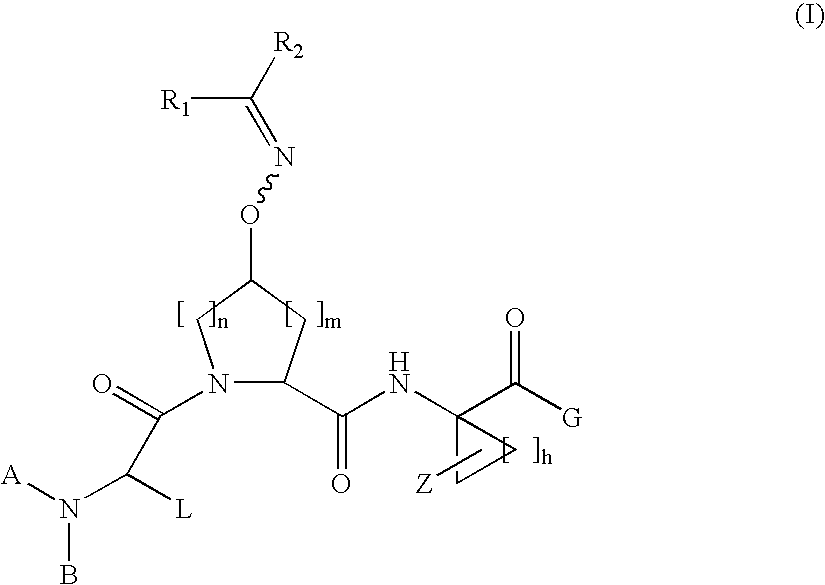Acyclic oximyl hepatitis c protease inhibitors
a technology of hepatitis c virus and protease inhibitor, which is applied in the direction of biocide, peptide/protein ingredients, peptides, etc., can solve the problems of interferon-related side effects, inability to reproduce infectious culture systems and small animal models for hcv, and increasing public health problems
- Summary
- Abstract
- Description
- Claims
- Application Information
AI Technical Summary
Problems solved by technology
Method used
Image
Examples
example 1
Compound of formula A, wherein Rx=Cyclopentyloxycarbonyl W=—O—NH2 and G=OEt
Step 1a.
[0325]To a solution of Boc-L-t-butyl glycine (2.78 g) and commercially available cis-L-hydroxyproline methyl ester (3.3 g) in 15 ml DMF, DIEA (10 ml) and HATU (5.9 g) were added. The coupling was carried out at RT overnight. The reaction mixture was diluted with 200 mL EtOAc and subsequently the extract was washed with 5% citric acid (2×20 ml), water (2×20 ml), 1M NaHCO3 (4×20 ml), and brine (2×10 ml), respectively. The organic phase was dried over anhydrous Na2SO4 and evaporated in vacuo, affording dipeptide which was directly used in the next step.
[0326]MS (ESI): m / z=359.20 [M+Na].
Step 1b.
[0327]A solution of dipeptide from step 1a dissolved in 15 mL of dioxane and 15 mL of aqueous 1 N LiOH solution was carried out at room temperature for 4 hours. The reaction mixture was acidified by 5% citric acid and extracted with 200 mL EtOAc, and washed with water (2×20 ml), and brine (2×20 ml), respectively. T...
example 2
Compound of formula I, wherein Rx=Boc, W=—OMs and G=OEt
[0339]To a solution of the acyclic peptide precursor from step 1c of Example 1 (500 mg, 1.04 mmol) and DIEA (0.543 ml, 3.12 mmol) in 10.0 ml DCM, mesylate chloride (0.122 ml) was added slowly at 0° C. where the reaction was kept for 3 hours. 100 mL EtOAc was then added and followed by washing with 5% citric acid 2×20 ml, water 1×20 ml, 1M NaHCO3 2×20 ml and brine 1×20 ml, respectively. The organic phase was dried over anhydrous Na2SO4, filtered and concentrated, yielding the title compound mesylate (590 mg) that was used for next step synthesis without need for further purification.
[0340]MS (ESI): m / z=560.32 [M+H].
example 3
Compound of formula B, wherein Rx=Cyclopentyloxycarbonyl L=tButyl R1 and R2 Taken Together with the Carbon Atom to which they are Attached are
[0341]
Z=CH═CH2 and G=OH
Step 3a.
[0342]The mixture of compound from step 1g of Example 1 (0.098 mmol), 9-fluorenone (0.1 mmol), HOAc (0.3 mmol) and pyridine (0.1 mmol) in MeOH was stirred at 40° C. overnight. The reaction mixture was extracted with EtOAc. The organic extracts were washed with 1M NaHCO3, brine, dried over Na2SO4, filtered and concentrated.
[0343]The residue was purified by silica gel chromatography to give desired product.
[0344]MS (ESI): m / z=671.24 [M+H].
Step 3b.
[0345]To a solution of the compound from step 3a in THF / MeOH was added 1NLiOH. The reaction mixture was stirred overnight at room temperature. After acidified with 1NHCl, the resulting mixture was extracted with EtOAc. The organic extracts were washed with water and concentrated. The residue was purified by preparative HPLC to give desired product 1 and product 2.
product 1...
PUM
| Property | Measurement | Unit |
|---|---|---|
| temperature | aaaaa | aaaaa |
| emission wavelength | aaaaa | aaaaa |
| excitation wavelength | aaaaa | aaaaa |
Abstract
Description
Claims
Application Information
 Login to View More
Login to View More - R&D
- Intellectual Property
- Life Sciences
- Materials
- Tech Scout
- Unparalleled Data Quality
- Higher Quality Content
- 60% Fewer Hallucinations
Browse by: Latest US Patents, China's latest patents, Technical Efficacy Thesaurus, Application Domain, Technology Topic, Popular Technical Reports.
© 2025 PatSnap. All rights reserved.Legal|Privacy policy|Modern Slavery Act Transparency Statement|Sitemap|About US| Contact US: help@patsnap.com



